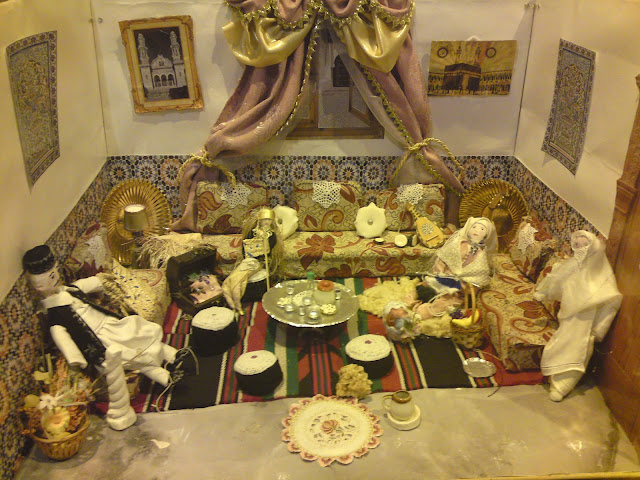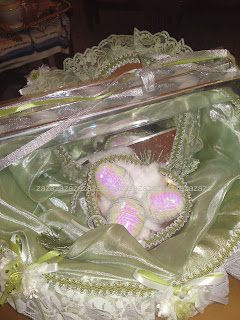These pictures reflect a number of traditional aspects, such as clothes, the decoration of houses indoors, the bridal Henna, boys circumcision, afternoon tea/coffee, El-Hemmam, Zawya and much more.
You'll also see various tools old tool (well, not that old, people still use them in the villages, moutains, the desert and many places outside the major cities). These tool involve, Shekwa, Qerdash, Loh, Siyyar, Lhafsa, Thashmoukhth, Azetta, Tajin, and much more.
The bridal Henna: it is a tradition in many -but not all cities- to have an evening or an afternoon to put Henna on the bride's hands and feet before her big wedding day. Family women, old and young, get together to share this moment of joy in the family. the grannies sit around the bride and sing. They sometimes beat the drum too. The dry henna is presented in decorated basket that consists of decorated eggs, candles, cotton pads or handkerchiefs to cover the henna once applied on the wife-to-be hand's. The 'head granny' sits at the brides knees, sings along and stir the Henna mix, put in copper pot, with her thumb. When the mixture is ready, she applies some on the bride's palm, forming a circle filled with Henna paste.
Boys circumcision: The Muslim families in Algeria circumcise their boys between the age of 1 month and 5 years old. Usually a great party is organised to celebrate the event. ladies perform the Yuyus ( a traditional "scream" if i can call it so?) special sets of blankets, napkins, bed sheets, table clothes, pillow cases and other linen pieces cover the room. The boy wears tradtional clothes, including a hat, long gown and cape and pointy soft embroidered slippers. He, then, gets taken to the doctor's to be circumcised and then brought back home and put to lie down on those new sets of linen. All family members shower the boy with money - even the neighbours get in the house to congratulate him and wish him the best. Nowadays, many families, in the major cities, organise big parties with DJ's or musical bands and invite people to have coffee.
 Afternoon tea/coffee: is an extremely important time of the day for many if not all Algerians. it is not because they cannot spend a day without tea or coffee. Rather, it is a sacred traditional time during which the family members get together. It's more of a social habit. It take place between 3 pm and 5 pm. During that time, the ladies make tea (mixing mint and green tea and bringing it to boil) or spooning some grounded coffee into the Cafetiere (press pot) sieve and leave it to concentrate. This hot drink are accompanied by traditional sweet, such as, Maqroot, Ghribiya, Griwesh, Rfiss, Braj, Neqqash, Samsa, Khfaf, Msemmen, Qnidlat, Dziriyat, mkhabez, tcharak and others.
Afternoon tea/coffee: is an extremely important time of the day for many if not all Algerians. it is not because they cannot spend a day without tea or coffee. Rather, it is a sacred traditional time during which the family members get together. It's more of a social habit. It take place between 3 pm and 5 pm. During that time, the ladies make tea (mixing mint and green tea and bringing it to boil) or spooning some grounded coffee into the Cafetiere (press pot) sieve and leave it to concentrate. This hot drink are accompanied by traditional sweet, such as, Maqroot, Ghribiya, Griwesh, Rfiss, Braj, Neqqash, Samsa, Khfaf, Msemmen, Qnidlat, Dziriyat, mkhabez, tcharak and others.  EL-Hemmam. Lets put it in a simple way. it's a public shower. Yep, that's right. It's a place, (a huge room, 2 or 3) that's as hot as a Sauna. There is little privacy, people usually shower using natural water from a hot source. There is never a mixed Hammam. they are ladies only or men only Hammams. If you're a lady going inside the Hammam, you'll be greeted by the receptionist. She'll also ask you if you need anything (towel, shampoo..etc). You, then, go to sitting/waiting area where you can put your things and undress. Don't worry, you won't get in there naked, ladies usually wear a Foota (a long sarong) and keep it on most of the time. In a pot, you pot your shampoo, oils, soap, comb, sponge or Kassa (exfoliator) and hair clips. Then you go into the hot room. Inside, you'll see that at each wall or the room, there are many basins with 2m distance between each other. Each basin has a tap for cold and hot water. So, you sit on the floor, facing the your basin and the wall, and you regular your water temperature. In the hot room work many individuals whom we call (Kiyassa). These ladies are responsible for giving you a massage and rubbing/exfoliating your back or any body part you need help with. They are professionals in removing dead skin, softening the skin and giving massage. They talk a lot while doing that. So, you would never get bored. once you're done with your washing, you wrap yourself well in a big towel and you get out to go sit and relax in the sitting/waiting area. Once settled and refreshed, you get dressed, paid the receptionist and leave.
EL-Hemmam. Lets put it in a simple way. it's a public shower. Yep, that's right. It's a place, (a huge room, 2 or 3) that's as hot as a Sauna. There is little privacy, people usually shower using natural water from a hot source. There is never a mixed Hammam. they are ladies only or men only Hammams. If you're a lady going inside the Hammam, you'll be greeted by the receptionist. She'll also ask you if you need anything (towel, shampoo..etc). You, then, go to sitting/waiting area where you can put your things and undress. Don't worry, you won't get in there naked, ladies usually wear a Foota (a long sarong) and keep it on most of the time. In a pot, you pot your shampoo, oils, soap, comb, sponge or Kassa (exfoliator) and hair clips. Then you go into the hot room. Inside, you'll see that at each wall or the room, there are many basins with 2m distance between each other. Each basin has a tap for cold and hot water. So, you sit on the floor, facing the your basin and the wall, and you regular your water temperature. In the hot room work many individuals whom we call (Kiyassa). These ladies are responsible for giving you a massage and rubbing/exfoliating your back or any body part you need help with. They are professionals in removing dead skin, softening the skin and giving massage. They talk a lot while doing that. So, you would never get bored. once you're done with your washing, you wrap yourself well in a big towel and you get out to go sit and relax in the sitting/waiting area. Once settled and refreshed, you get dressed, paid the receptionist and leave.
Zawya: is a place (a big class room) where young and older learners go to learn Arabic for Quran purposes. They don't study the language as such, they just study how to read and write. They use wooden long stick or brushes to write on a thin wooden plank. They dip the stick into a put full of ink and write the Quranic verses to memorise them. In that classroom, learners memorise the Quran and recite repeatedly until they've memorised it perfectly. Some individuals decide to live there for a period of time, in order to be fully exposed to Quran and facilitate memorisation for themselves. They also seek high spiritual levels by doing that. Beds and catering are provided.
Shekwa: is a container of liquids made of animal skin. It is usually use either to preserve water, or most frequently to churn milk. Ladies sit under a tripod where the Shekwa hangs in the centre and churn repeatedly.
Qerdash: carding paddles: is a tool that look like two combs rubbed against each other. It is used to unravel wool and to make it softer and thinner.
Loh: is a wooden plank used for washing clothes . Ladies put the clothes on it and rub them against it.
Siyyar: (picture) is a huge sort of sieve. It filters grains, semolina, and other foods. It's got a circular shape made of wooden edges and a metal sieve in the centre.
Lhafsa: is a woomen basin looking container. It is thick and made of wood. Ladies use it to make Cousous and other traditional dishes.
Tajin: a base made of clay used for cooking and grilling bread, and other traditional noms. It sometimes come with a cover that's got an upside down cone. It's used to cook stews and meat.
Heedora: is taken from sheep, goats and cow. It is the skin with fur of these animals. People treat this skin and soften it. They put it indoors on the floor as rugs to sit on, decorate the place or sleep on.
Derbouka: a musical instrument similar to a drum. It's handheld, shaped like a vase and traditionally covered with goat skin.
Goumbri: is a a kind of bass (a musical instrument).
Thasirth: is a wheat grounding tool. It's made of stone and it consists of two main parts: a base and a spinning top with a hole in the middle (looking like a well) through which you pour wheat grains.
 |
| . |















 |
| My cousin's 100% handmade dolls |


























 |
 |
| an Amazigh girl being drawn on the spot. |
















































No comments:
Post a Comment